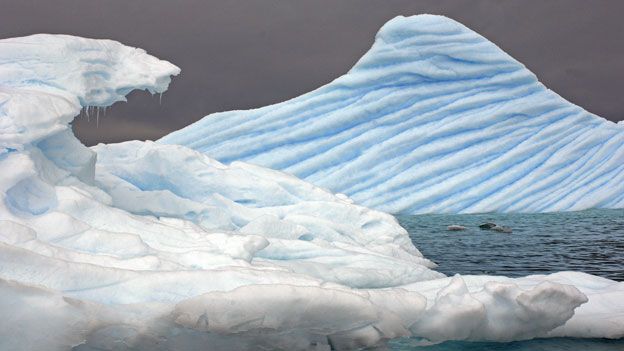Who, What, Why: How do you track an iceberg?
- Published

A large iceberg has broken off a glacier in northern Greenland. Where will it go - and how do you track an iceberg?
At twice the size of Manhattan, the iceberg that has just calved from the Petermann Glacier, is not hard to miss.
It can easily be seen on satellite images and is nestled within the glacial fjord.
But once it gets out to open sea, it will drift and start to break up into smaller pieces, in a way that is virtually impossible to predict, says Trudy Wohlleben, senior ice forecaster with the Canadian Ice Service.
She tracks satellite data for icebergs, and was the first to spot this new iceberg, as well as a previous one - twice the size - which calved from the same glacier in 2010.
Water currents and the wind are two of the main forces at play in determining where an iceberg goes.
Most of the tracking is done by satellites, but as the iceberg breaks up into smaller and smaller pieces, they become hard to see.
"Icebergs drift and melt until they're eventually impossible to detect by satellite because they are so small," says Eric Rignot, senior research scientist at Nasa's Jet Propulsion Laboratory.
Small icebergs are called bergy bits (around the size of a grand piano) or growlers (about the size of a small house).
And anything growler-sized or smaller, is tricky for a satellite to pick up.
But these small icebergs pose a big threat to ships.
"Large icebergs are reasonably visible - it's the smaller pieces that become a problem for shipping," says Captain David Snider, an ice pilot and navigator, who help ships chart a safe passage through icy waters.
"They can be quite hidden by rough seas, and what you can't see is harder to avoid."
One technique to get around this problem is to drop satellite tracking beacons onto the icebergs, which send a signal showing their location, much like a GPS system.
They are positioned either by landing on the iceberg in a helicopter, says Trudy Wohlleben, or by dropping the beacon - attached to its own mini-parachute - from an airplane.
But there are logistical problems: "The batteries only last around one year, and then you need to replace them."
Two years after the first big iceberg calved from Petermann Glacier, Wohlleben and her team are still tracking it. "There's quite a bit left," she says.
It took about one month to "manoeuvre its way out of the narrow space" of the fjord, says Wohlleben.
Once out, it broke into two halves, and a year later, one of those bits reached Newfoundland.
"It started doing little circles, and breaking into smaller icebergs. It was quite close to land, and they could see it from the International Space Station."
The second half - a large chunk around 40 square km (15 square miles) - is currently grounded off the east coast of Baffin Island.
"Like a ship, when it gets too close to the shore, it hits the bottom.
"Sometimes we see it pivoting. One little corner is stuck to the bottom, so it may float free," says Wohlleben.
So could the course of the 2010 iceberg help predict where this one will go?
It probably won't be that simple. "It's really difficult. You can have two pieces next to each other and they just diverge and go different ways," she says.
"That's what happened [in 2010] - the leading fragment just took off."
It is not just ships that are threatened by icebergs - off-shore oil platforms are also at risk, and at one stage, part of the 2010 iceberg looked like it was heading towards one.
Ships have the advantage that they can move out of the way. Though an oil rig can move, it is not something that be activated quickly, and is seen as a last resort, says Stephen Green with Provincial Aerospace Ltd, a company that specialises in protecting oil platforms from icebergs.
To complement the satellite data, his firm sends airplanes with radars to help track an iceberg's movements.
When an iceberg is heading for an oil platform, they step in to divert its course, or - if it is small enough - break it up with water cannon.
If it is a large iceberg, they either lasso it with a rope (tricky if the iceberg is quite flat), or catch it in an ice net, thrown off the deck of a ship.
The most important thing is to stay as far away from the iceberg as possible.
"They are always breaking apart - always. So you shouldn't go anywhere near them unless you have to, they are incredibly dangerous," says Green.
Once lassoed, "we'll tow the iceberg away from the platform to a safe place where it just drifts off".
Reporting by Cordelia Hebblethwaite